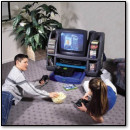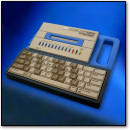Archive for the 'Retro Scan of the Week' Category
[ Retro Scan of the Week ] TRS-80 Word Processing
Tuesday, September 8th, 2009 Click above to see the ad in situ.
Click above to see the ad in situ.
Here’s another vintage clipping from my grandmother’s cedar chest, this time from a Knoxville, TN newspaper. It mentions SCRIPSIT, early word processing software for the TRS-80 computer line.
Discussion topic of the week: What was the first word processing software you ever used?
[ Retro Scan of the Week ] Super Mario World 2
Monday, August 31st, 2009 “He goes all over the place (and we don’t mean Number Two.)”
“He goes all over the place (and we don’t mean Number Two.)”
Here’s a classic advertisement for Super Mario World 2 from the “Play it Loud” era. Baby Mario looks quite destructive.
In the mid-1990s, Nintendo tried to downplay its kiddie image and appeal to the “I’m-awesome-because-I-huff-Easy-Cheese” teenage set. The company’s American branch formulated a new “Play it Loud” ad campaign to directly counter aggressive advertising from Sega.
Nintendo’s new marketing theme focused on the stereotypical angsty “attitude” of youth in transition, which, in print, mostly translated to grungy fonts, eye-gougingly garish design, and scatological humor. Surprisingly to some, the campaign actually worked — Nintendo regained the lead in the 16-bit market right as that era was ending.
On another note, Super Mario World 2 is one of the best Super NES games, and definitely one of the most underrated. If you haven’t played it yet, you’re missing out on a platforming masterpiece. Drop everything and get yourself a copy. And don’t forget to play it loud(ly).
Discussion topic of the week: What’s the most underrated Super NES game?
[ Retro Scan of the Week ] The $99 Floppy Drive
Monday, August 24th, 2009Nothing illustrates the frenetic pace of technological change like past/present price comparisons. As seen in this group ad by JDR Microdevices, a 1.44MB 3.5″ floppy disk drive sold for US $99.95 in 1990 ($164.69 in 2009 dollars). But that’s just for the generic model — for a name brand Misubishi, you had to pay $129.95 ($214.12 in 2009).
That’s quite a price for a now-obsolete commodity device that sells for $7.99 today (or $4.85 in 1990 dollars, interestingly enough). Of course, in 1990, a high density drive like this was cutting-edge.
As an aside, notice that the 3.5″ floppy drive pictured occupies a 5.25″ half-height form factor. That shows you how old this is — at the time, most owners slid 3.5″ upgrade drives into computer cases that only shipped with 5.25″ half-height bays (this bay size commonly holds desktop DVD-R drives today). To do so, many 3.5″ floppy drives needed a special face plate and brackets to fill the gaps between the smaller drive and the larger bay around it.
Discussion topic of the week: What’s the most you’ve ever paid for a computer peripheral or upgrade component?
[ Retro Scan of the Week ] Dungeons and Demons — The Infraceptor Watch
Monday, August 17th, 2009Does anybody know more about this interesting looking watch? I don’t recall seeing or hearing anything about it beyond this tiny profile in Popular Science’s “What’s New” section back in 1995.
Casio’s Infraceptor watch functions as a game machine, a phone book, an infrared message sender, and a stopwatch. Its IR beam lets you play a “dungeons and demons” adventure against other Infraceptor users. You prepare the phone book information — for as many as ten people — or canned questions and replies for the message-sending function on a JD-6000 Digital Diary before storing it in the watch. Price: $100.
I wonder how the so-called “dungeons and demons” game worked. I’m completely guessing here, but I suspect it wasn’t very fun. It’s still a neat concept that I would have killed for as a kid (I can imagine surreptitiously playing it at school).
Check out this neat Japanese page with pictures of other super-nerdy watches on it.
Discussion topic of the week: Tell us about the geekiest watch you’ve ever owned. (i.e. Calculator? Digital address book? Built-in camera? Dick Tracy-style radio?)
[ Retro Scan of the Week ] Compucolor II
Monday, August 10th, 2009 Finally. A respectable computer. Took long enough.
Finally. A respectable computer. Took long enough.
The Compucolor II was one of the world’s first personal computers with color display capabilities. It’s now quite rare. Does anybody out there have one that they don’t want?
Discussion topic of the week: Have you ever regularly used a computer without a color display? If so, tell us about it.
[ Retro Scan of the Week ] A Little Too Real
Monday, August 3rd, 2009[ Retro Scan of the Week ] Shugart Floppy Sandwich
Monday, July 27th, 2009 Click above for the full advertisement.
Click above for the full advertisement.
Just your typical late-1970s scene — a poofy-haired car salesman at home in a tie with a huge sandwich, a glass of milk, a large set of keys, a generic S-100 bus computer with a TV terminal, and a book called “Trout” behind him.
He likes to fish.
Of course, the whole purpose of this scene is to push the use of “genuine” Shugart mini-floppies in the home. Shugart, if you didn’t know, invented the mini-floppy. And mini-floppies, if you didn’t know, are commonly known as 5 1/4″ diskettes today. They replaced the giant 8″ clown disks people used before that (read your comments about 8″ floppies here). Sadly, these smaller disks held less data at the time, but that was a small price to pay for not knocking over your friends while swapping storage media.
Discussion topic of the week: Do you still use 5 1/4″ floppies to store new or recent data? If so, what are you using them for?
[ Retro Scan of the Week ] Half-Naked Astroman
Monday, July 20th, 2009 MegaWars: “The Ultimate Computer Conflict”
MegaWars: “The Ultimate Computer Conflict”
I betcha Neil Armstrong didn’t do this while he was on the moon.
…or did he?
P.S. You can read more about MegaWars, an early online multiplayer computer game, here.
Discussion topic of the week: If you were a half naked combat-astronaut on an artificial planetoid, what would you do for fun?
[ Retro Scan of the Week ] Multi-Platform Mania
Monday, July 13th, 2009 “8 Ways You Can Play Frogger at Your Pad.”
“8 Ways You Can Play Frogger at Your Pad.”
These days, big name games usually come out on a couple different platforms: Xbox 360 and PS3, and sometimes PC or Nintendo DS. But imagine a time when a standard multi-platform game release included eight computers and video game systems: Atari 5200, TI-99/4A, Atari 400/800/600XL, Intellivision, Commodore VIC-20, Atari 2600, Commodore 64, and Colecovision.
That time was 1983, as seen in the ad for Frogger above. Thanks to the lack of a common standard in home computers at the time, there were actually far more than eight computer platforms available in the early 1980s, but some of the most major are listed above (along with the main video game consoles of the day). I bet it was an enormous effort to coordinate the development and release of all those different versions within a short window of time.
Discussion topic of the week: For those who were there: How many computers/consoles did you own simultaneously around 1983?









